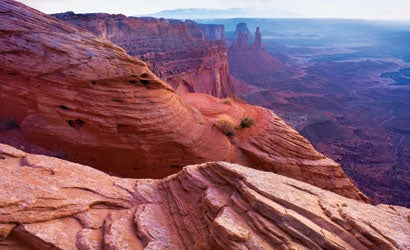Landscape Cheat Sheet
Baffled by beauty? Try these foolproof formulas for stunning landscapes.

Not sure how to compose your landscape photos? Use these templates to get started. Try them in pure form, or in combination, depending on the circumstances. Once you are tuned in to the possibilities, you’re sure to find one of these iconic compositions lurking on the horizon every time you set foot afield. And when you’re comfortable with the template approach, devise your own scenic concoctions!
Intersecting Layers:
Canyonlands National Park. Framing is key. Include a maximum number of prominent intersection points, and use a UV, polarizing, or split ND filter to boost midtone contrast. Mamiya 645 AFd with Phase One P25 back and 55-110mm f/4.5 Mamiya- Sekor lens on tripod. Exposure, 1/2 sec at f/22 through Singh-Ray 1-stop split ND filter, ISO 100.
Intersecting layers:
Intersecting landscape planes generate strong, pleasing diagonal shapes. Use a zoom that allows tight framing of several well-defined points of intersection, and a polarizing or UV filter to reduce haze and maximize color contrast.
Snapshot:
At scenes of undeniable grandeur, a simple, centered take is all you need — so point and shoot. For best effect, this template depends on detail revealed under front- or sidelight. Simplicity is everything here, so make sure your framing is tight and balanced by using a tripod and zoom lens.
Railroad tracks:
Such scenes contain slender parallel forms telescoping into the distance — stream beds, sand dune ripples, striated rock formations. Avoid framing that allows any of the parallel edges to run into the picture corners. Position the camera low and close to the parallel lines for exaggerated perspective effects.
Foreground feature:
Base the composition on a compelling landscape detail — a wildflower clump or lichencrusted rock. Position the foreground element and landscape feature catty-corner to each other — for example, in the upper left/lower right of the frame. Aim the camera 45 degrees downward on the near features while placing the horizon within the top fifth of the frame.
S-curve:
Scenes with long prominent shapes (such as rivers) offer classic S-curve compositions. A polarizing filter lets you adjust reflection from watercourses to accentuate captivating curves. For tumbling water, use a shutter speed of about 1 sec or more to create graceful silky flows.
5 Favorite Tripod Features
When choosing a tripod for shooting landscapes, look for:
• Light weight for easy trekking to remote locales.
• Enough height to bring camera to eye level with center column down.
• Compact ballhead for quick action and easy carry.
• Long center column for eye-level shooting on slopes (e.g., river banks, hillsides).
• Three-section, no-brace, clip-lock legs for quick, jam-free operation.
For more landscape photography advice, see A Matter of Perspective — an excerpt from Fitzharris’s latest book, National Audubon Society Guide to Landscape Photography (Firefly Books, $25).